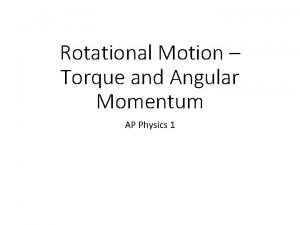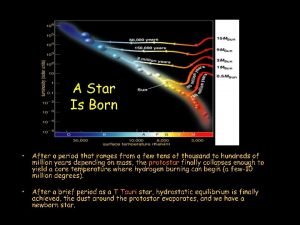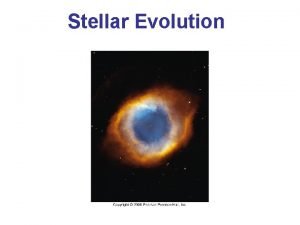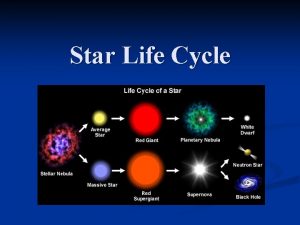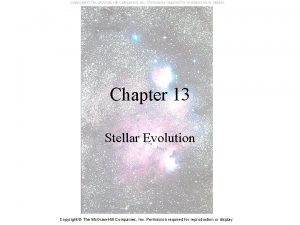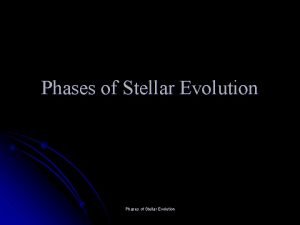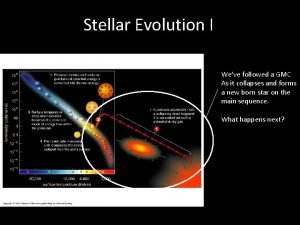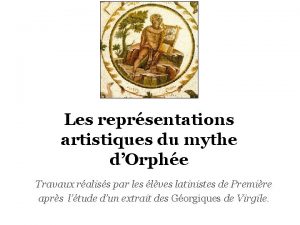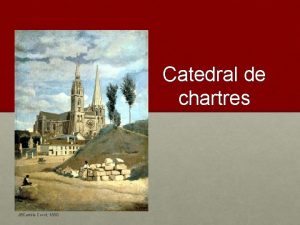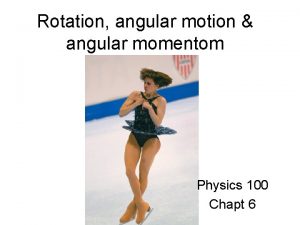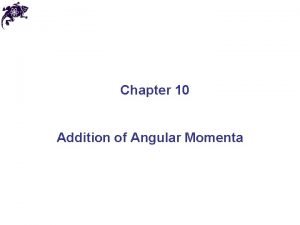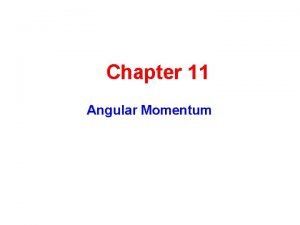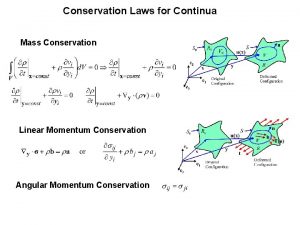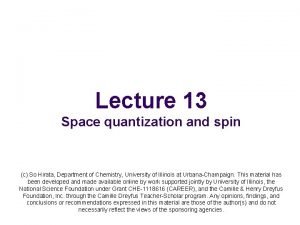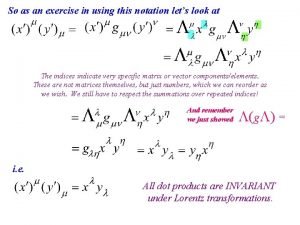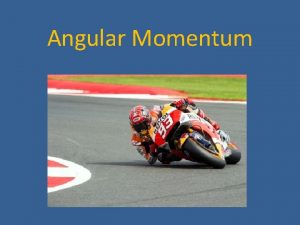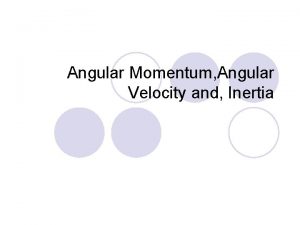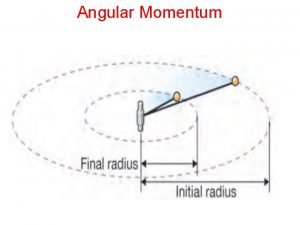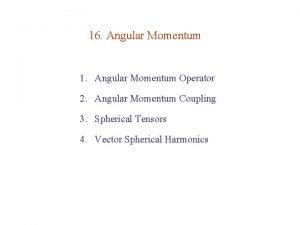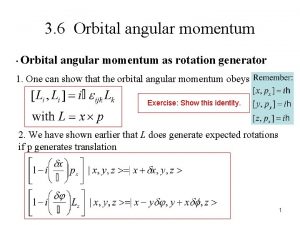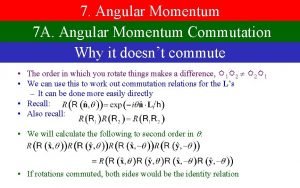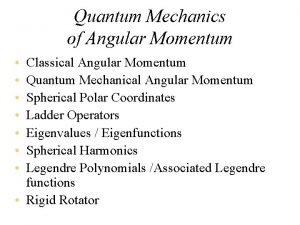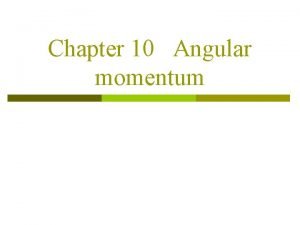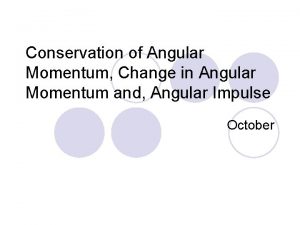Stellar angular momentum evolution in the COROT Mission


















- Slides: 18

Stellar angular momentum evolution in the COROT Mission Jose Dias do Nascimento PROFIX / CNPq (Natal / Brazil)

COROT : Rotation of solar-type stars from the main sequence to the Red Giant Branch Jose Renan de Medeiros UFRN José D. do Nascimento UFRN Igor F. dos Santos UFRN Bruno L. Canto Martins UFRN Izan C. Leão UFRN Lício da Silva Gustavo P. Mello Eduardo F. Del Peloso Beatriz Barbuy Cláudio Melo ON Obs. Valongo USP ESO

COROT : Rotation of solar-type stars from the main sequence to the Red Giant Branch • The behavior of surface rotation of solar-type stars (masses between 0. 9 and 1. 4 solar masses) along an evolutionary track from the main sequence to the RGB. • This may have deep impact on our understanding of stellar angular momentum evolution, in particular on solar rotation evolution.

The evolving Sun • Geneva - Toulouse Code • Standard Evolution do Nascimento et. al 1999 In addition to evolutionary expansion, which physical processes control the behavior of rotation along the HR Diagram?

The Rotation evolution (vsini) Over the past 10 years it has become possible to measure projected rotational velocities with high recision and, as a result, some very interesting new features on the behavior of stellar rotation are emergi Figure shows the well established rotational discontinuity around the spectral type F 8 IV corresponding to (B-V) ~ 0. 55 (log. Teff = 3. 78). do Nascimento et. al 1999, We can see clearly that single subgiants redward of the discontinuity with high vsin i are unusual. The root cause for such a discontinuity seems to be a strong magnetic braking associated with the rapid increase of the moment of inertia, due to evolutionary expansion, once the star evolves along the late F spectral region ( De Medeiros and 1990). Fig. 1 Distribution of subgiant stars in the HR diagram, with. Mayor the rotational behavior as a function of luminosity and effective temperature. Luminosities have been derived from the HIPPARCOS parallaxes. Evolutionary tracks at [Fe/H]=0 are shown for stellar masses between 1 and 4 M (do Nascimento et al 2000 for a more detailed description). The dashed line indicates the beginning of the subgiant branch and the dotted line represents the beginning on the red giant branch.

The evolving Sun do Nascimento et. al 1999, do Nascimento et. al 2003

Mixing in Low Mass Stars A(Li) and on the subgiant branch do Nascimento et. al 1999 Portion around 1 transit For most of the stars we find good agreement with the dilution prediction The evolutionary status of the sample as well as the individual masses have been determined 4 transits summed together Time (hrs) However, some stars show a significant discrepancy with theoretical prediction, even if the Non-LTE effects are taken into account

Meridional circulation Gradients of Shear instabilities Zahn 1992: strong horizontal turbulence Transport of the chemical species Transport of the angular momentum

Palacios et al. 2004 A&A

A(Li), Vsini and Convection do Nascimento et. al 1999 Portion around 1 transit 4 transits summed together Time (hrs) The deepening (in mass) of the convective envelope as a function of the effective temperature (first dredge-up) and [Fe/H] = 0. No transport processes except for the classical convective mixing (with a value of 1. 6 for the mixing length parameter) are taken into account. The predicted dilution factor at the end of the dredge-up ranges between 20 and 60 low lithium content of some subgiants cannot be accounted by dilution alone Mixing model have some free parameters

A(Li), Vsini and F(Ca) do Nascimento et. al 2002 A&A We have analyzed the behavior of the vsini, chromospheric flux and lithium abundance across the subgiant branch. Portion around 1 transit A sample of 121 stars, along the spectral region F, G and K, with rotational velocity, flux of Ca. II and A(Li) Flux index catalogue by Rutten (1987) 4 transits summed together Time (hrs) Different authors have reported for a rotation-activity relation for evolved stars based on the linear behavior of the chromospheric flux against stellar rotation (e. g. : Rutten 1987; Rutten and Pylyser 1988; Simon and Drake 1989; etc)

The evolving Sun Markers spaced by 250 million years The left-hand side of the disk shows the size with time. Portion around 1 transit The right half of the sphere shows the radiative core and the depth of the convective envelope (dark). 4 transits summed together Time (hrs) Three half-circles show where 25%, 50%, and 75% of the mass is contained The mass fraction in the convective envelope and the moment of intertia for the convective envelope are shown do Nascimento et. al. , A&A 1999

The evolving Sun Description of the Targets The main goal has been to select solartype stars loosely defined as bona-fide dwarfs, subgiants and giants stars aligned along theoretical evolutionary tracks of stars with 0. 9 -1. 4 solar masses. This translates approximately in the limits +0. 5 < (B-V) < +0. 8 and 6. 0 < MV < +2. 0. The apparent magnitude limit is V = 9. 0, as a guarantee towards completeness of photometric data for the targets as well as to facilitate the subsequent acquisition of spectroscopic data by ground-based telescopes. The result of this selection is a sample of 30 and 22 targets, respectively, in the 06 h 50 m and 18 h 50 m COROT fields. do Nascimento et. al. , A&A 1999

Rotation Connection with Activity and Mixing Which physical processes control the behavior of rotation along the HR Diagram? There is some conjecture that the mixing maybe driven by rotation and thus depend upon the rotational history of the star. How is the angular momentum transported and is it related to particles transports ? How does magnetic braking affect rotation? How does rotation affect internal mixing processes? Does rotation controls dynamo process and stellar activity?

The evolving Sun Anticenter positions_V 9 Description of the Targets V<8 8<V<9 + 11 < V < 16 Exo. Field

The evolving Sun center positions_V 9 Description of the Targets V<8 8<V<9 + 11 < V < 16 Exo. Field


 Theorem of angular momentum
Theorem of angular momentum Stellar evolution diagram
Stellar evolution diagram Stellar evolution
Stellar evolution Stellar evolution diagram
Stellar evolution diagram Stellar evolution
Stellar evolution Stellar evolution diagram
Stellar evolution diagram Stellar evolution
Stellar evolution Flowchart of the life cycle of a star
Flowchart of the life cycle of a star Arica en 100 palabras
Arica en 100 palabras Dorphe
Dorphe Catedral de chartres corot
Catedral de chartres corot Catedral de chartres corot
Catedral de chartres corot Lycee morestel
Lycee morestel Right hand rule momentum
Right hand rule momentum Clebsch gordan coefficients
Clebsch gordan coefficients Vector angular momentum
Vector angular momentum Conservation of linear momentum
Conservation of linear momentum Spin angular momentum formula
Spin angular momentum formula Spin angular momentum formula
Spin angular momentum formula
